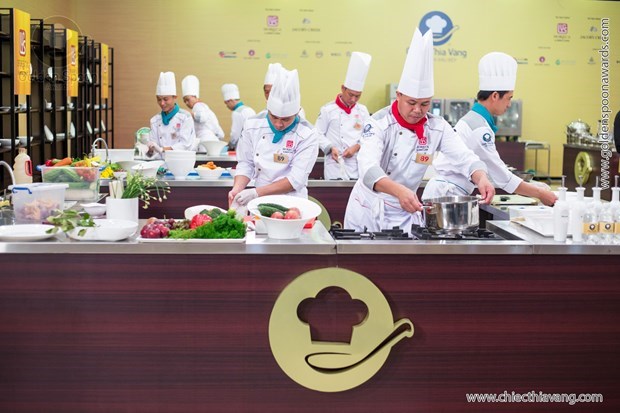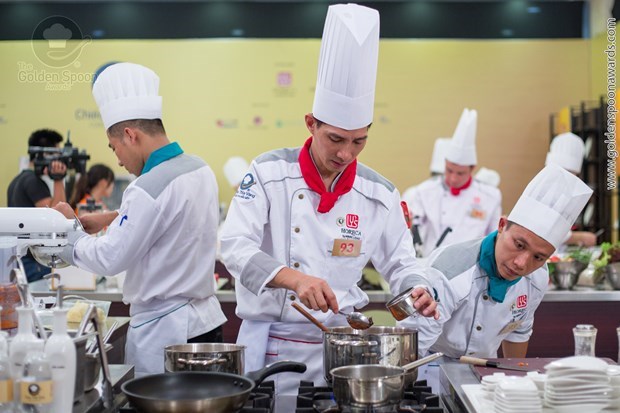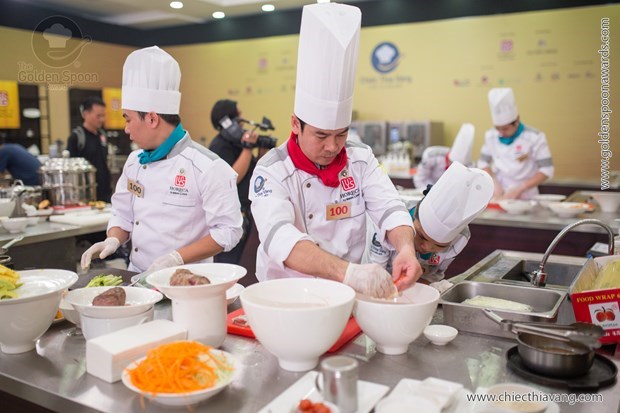The semifinal for northern regions of the Golden Spoon
Awards 2016 took place in 27 and 28 September 2016, witnessing a multi-color grand
feast filled with novelty values in the so-called “hub of Vietnamese cuisine”
or “the land of strictly followed rules and conservative style”.
Northern highlands: Home of food
with medicinal values
Known as “the capital of spices”, the Northern highlands are
considered an ideal destination for new flavors and excursion into exotic
spices for the Golden Spoon Awards judges and participants. Multiple herbs had
played a leading role in the menu of several teams, such as da hien leaf, barrenwort, cistanche, chinese
black olive, rose myrtle, creek premna, sichuan pepper, anise, rock salt,
etc.
According to Oriental medicine, chinese black olive is
believed to cool down and detoxicate the body as well as protect liver against
diseases. Wormwood, in the meantime, helps remediate blood circulation,
maintain regular menstrual cycle and pregnancy, an effective therapy for rash
treatment, sciatica and aching joints. Barrenwort, balanophoran fungus and
cistanche are all listed in the Book of
Invaluable Herbs and Herbal Medicines in Viet Nam, possessing features that
benefits liver health, strengthen bones and joints as well as cure arthritis.

Sa Pa – one of the famous tourist attractions in the North
is a hot spot of reputable highland cuisine. Popular ingredients such as salmon, cod, black-bone silky fowl, Seng Cu
sprouted brown rice and Bac Ha plum along with herbs like doi seed, morinda root, radix pseudo ginseng flower have together brought
medicinal, healthy values to following dishes: eel wrapped in guava leaf served with chinese black olive sauce, stewed
black-bone silky chicken wing in radix pseudo ginseng flower, simmered
black-bone silky chicken in bamboo tube, lamprey eel soup with lolot leaf,
wormwood cake, etc.
Red
River region: plenty of
specialties
Although food in the North is not as diverse than that in
the South, it has certain cultural notions and geographical distinctions. Ranked
in 50 Top Vietnamese Special Dishes, Ninh
Binh mountain goat – firm, lean chevon of goats inhabiting around the limestone
mountains, is cooked medium, grilled or made into fresh rolls with vegetables. Also,
Tien Yen chicken gets its reputation for a special ingredient - pastured-raised
chicken that is succulent, chewy but not greasy. Further down to the sea level,
the midland has embraced the bucolic variety of local ingredients, such as eel
and yellow perch, to take up their space in high-class banquet menu.

Along the coastline of Tra Co, there live a multitude of exotic
sea creatures, for instance, Cu Ky shore crab,
peanut worm, sea grapes, etc. Specifically, Cu Ky crab has juicy flesh, featuring in various recipes of noodle
soup, vermicelli soup, glass noodle soup and so on. Cai Rong fish sauce, a Quang Ninh specialty, with its caramel
color, pungent whiff and sweet aftertaste, is widely used to season for another
great number of dishes. All aforementioned examples reinforced fusion – a cooking trend which
encourages the concoction of many local ingredients in remarkable dishes: deep-fried seafood on sliced rice paper,
rare chevon in lime juice, grilled chevon with potato cake and fermented rice
and galangal sauce.
Ha Noi – Capital of culinary
confinement
Ha Noi cuisine has been bearing in it a unique, indigenous
culinary culture that amazes tourists from all over the world, thanks to pho (beef noodle soup), banh tom (shrimp donut), banh cuon (steamed roll), com (roasted green rice), etc. With
their extraordinary meticulousness and creativity towards the capital
specialties, chefs competing in Golden Spoon Awards have brought about new styles
of cookery for traditional Ha Noi dishes of cha
ca La Vong (fried fish cake), vit Van
Dinh xot hung lang (duck with Lang basil sauce), ca ro dam Set (Set swamp yellow perch), cha oc Tay Ho (Westlake escargot paste).

In addition, sensational menus with traditional courses,
evoking childhood memories in any Vietnamese people who spent most of their
childhood in the Tonkin districts, such as nem
Bui (fermented pork skin cake), banh
phu the (husband and wife cake) by Pullman Hotel Hanoi, com don (sweet potato stuffed with
rice), wild vegetables, oc nau chuoi dau (braised
escargot in green banana), dong que xu
Doai (stir-fried eel and frog with herbs) or novel deviations of nem cuon socola (chocolate roll) by Silk
Path Hotel, banh com Ha thanh (Ha Noi
green rice cake) by Duong’s Restaurant) deemed impressive with their ingenious,
out-of-the-box thinking when it came to mixing ingredients, spices and presentation.

Especially,
the chefs also utilized different Western cooking techniques and actively
responded to global cookery trends. The 5-star team of InterContinental Hanoi Westlake put effort in the competition when
heavily invested in centrifuge, sous vide
machine, nitrogen, etc. as well as performed slow-cooking technique – a
method to reserve the most nutrients that are good for diners, in several
recipes: wagyu beef, duck wonton, rising
sun styled nata de coco with mango flavor, and so on.
Conclusion:
The significance of all recipes featured in this regional
semifinal lied in the delicacy and elegance of the food presentation and
decoration. Local specialties were re-invented with local herbs and integrated
with new, offbeat ingredients to differentiate, and hence, show off the
richness of Vietnamese cuisine. Mrs Trieu Thi Choi and Mr Chiem Thanh Long,
members of the judge panel, agreed that the semifinal had done an excellent job
to honor the culinary explorers and their diverse experiences of mountain,
flatland and even urban cuisines, which motivate them to keep finding new local
flavors and sharpen their skills by applying new cooking methods into familiar
Vietnamese food.
In a closing note, we would like to announce the result for:
*Northern Highland region:
1st Prize: Dung Tan – Thai Nguyen Restaurant
(Team No. 80)
2nd Prize: Muong Thanh Lao Cai Hotel (Team No.
81)
**Red River region:
1st Prize: Emeralda Resort & Spa Ninh Binh
(Team No.90)
2nd Prize: Ha Long Wonder International Tourism
Joint Stock Company (Team No. 87)
*** Ha Noi Region:
1st Prize: InterContinental Hanoi Westlake
2nd Prize: Silk Path Hotel (Team
No.95), Duong’s Restaurant (Team No.96), Pullman Hanoi Hotel (Team No.99), Movenpick
Hotel (Team No.100), Hilton Hanoi Opera Hotel (Team No.103).
By The Golden Spoon Award